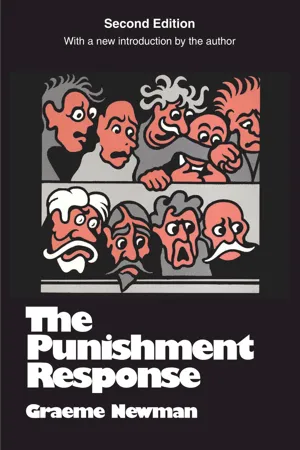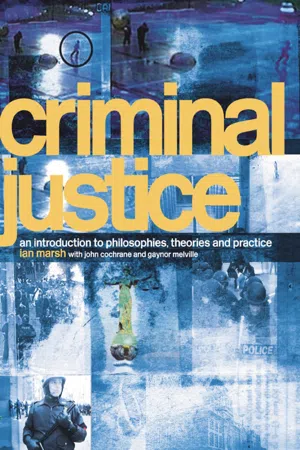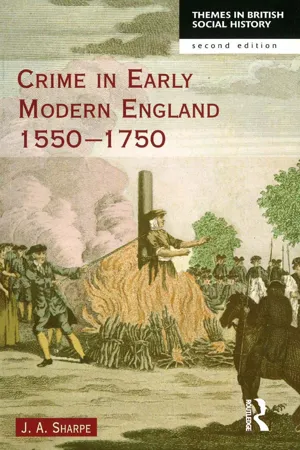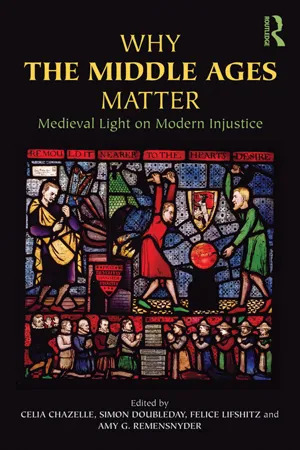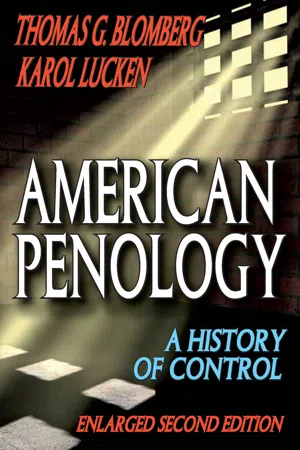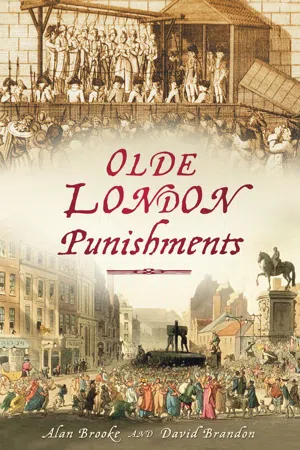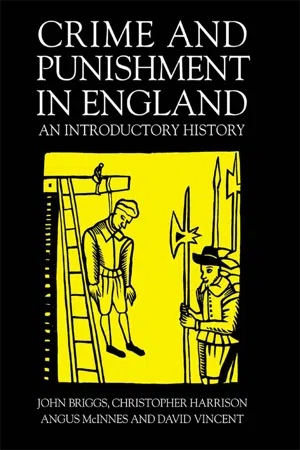History
Crime and Punishment in Medieval England
In medieval England, crime and punishment were heavily influenced by the feudal system and the Church. Punishments for crimes varied widely, from fines and public shaming to physical mutilation and execution. The legal system was also characterized by trial by ordeal and the use of local courts, with the king's authority gradually asserting more control over law enforcement.
Written by Perlego with AI-assistance
Related key terms
11 Key excerpts on "Crime and Punishment in Medieval England"
- eBook - ePub
- Graeme Newman(Author)
- 2017(Publication Date)
- Routledge(Publisher)
6 Punishing CriminalsI have so far concentrated on death and other bloody punishments from the point of view of their sacred origins or their rather narrowly defined use in the service of obedience within family, school, or religion. It is now time to place the use of punishment into a broader political perspective, by analyzing the relationship of punishment to the economic and social structure of society. I will do this very briefly for the period prior to the middle ages, and then concentrate specifically on the development of criminal punishment in English history.1Punishment up to the Middle Ages
If I have given the impression so far that the major forms of punishment in ancient times were those of bloodthirsty physical injury, I must apologize for a little sleight of hand. In proportion to other punishments that we would consider mild today, such as fines or compensations, severe physical punishment was not the most common form used in ancient times. The death penalty, for example, was used rarely in classical Greece, although often pronounced for serious crimes. In Athens the more common punishment was to banish the criminal by the vote of 6,000, and if the criminal refused banishment, then the death penalty followed. Socrates could have elected exile had he wished. This practice was continued on a much greater scale by the Romans, who encouraged those under death sentence to go into voluntary exile. In general, in classical Greece only those criminals caught in flagrante delicto were executed, and this was done on the spot by special commissioners appointed for the purpose.2In classical Rome the death penalty was almost never inflicted,3 although there is some disagreement in the literature as to whether this applied also to slaves. The only crime for which capital punishment was administered arbitrarily was for furtum manifestum, a thief caught in the act, who was executed on the spot, preferably by the accuser. This apparently overzealous punishment is directly related to the central part that the Roman house and family played in Roman law. Free men were certainly rarely executed from second to first centuries B.C.—the height of the Republic. And it was not until A.D. 250 and 257 that the great persecutions of the Christians occurred under the Emperor Valerian, and this again only for a very brief period.4 - eBook - ePub
Criminal Justice
An Introduction to Philosophies, Theories and Practice
- Ian Marsh, John Cochrane, Gaynor Melville(Authors)
- 2004(Publication Date)
- Routledge(Publisher)
Albion’s Fatal Tree: Crime and Society in the 18th Century, Harmondsworth: Penguin. A classic historical analysis of the use of the criminal law as an ideological weapon. It focuses on the manipulation of the ‘Bloody Code’ by ‘an astute ruling class in their own interests’. Hay’s essay ‘Property, Authority and the Criminal Law’ is particularly recommended as a study of eighteenth-century capital punishment.Morris, N. and Rothman, D. J. (1998) The Oxford History of the Prison: The Practice of Punishment in Western Society, Oxford: Oxford University Press. This provides a comprehensive coverage of the history of incarceration from ancient times to the modern day. Examples are drawn from Britain, continental Europe and the United States.Sharpe, J. A. (1999) Crime in Early Modern England, 1550–1750, 2nd edn, Harlow: Longman. An excellent, wide-ranging analysis of crime, criminality and punishment in the early modern period. Especially useful are chapters 3 and 4 on measuring and controlling crime. Chapter 5 is a valuable study of offenders which includes a useful section on gender. Other areas covered include popular attitudes to criminality and elite perceptions of crime and threat.Passage contains an image
4 Victimology
Introduction
It goes without saying that any criminal justice system will be preoccupied with the behaviour, the punishment and the rehabilitation of the criminal. The behaviour of the criminal has been the particular focus of criminology, although work in this area overlaps with a number of academic disciplines, including sociology and psychology. As regards the punishment of offenders, the different aims of and justifications for punishment, whether they be essentially retributive or reformative, have sparked continued philosophical debate. However, this academic obsession with the criminal has been at the expense of detailed consideration of the victim. Indeed, the victim often seems to be added to criminological theorising and debate merely out of politeness or political correctness. The consequences of this omission are important. The lack of academic interest has left the victim in the dark – a situation that has led to a good deal of public policy making not being informed by the needs, wants and status of the victim within the criminal justice system. - eBook - ePub
- James A Sharpe(Author)
- 2014(Publication Date)
- Routledge(Publisher)
Disputes in this region were normally settled by persuasion or reasoning, and by legal means if these failed: physical violence was rarely resorted to. 27 Violence and lawlessness were probably high by modern English standards, but not sufficiently so to constitute a society Which was qualitatively different. Certainly the portrayal of early modern (and, in all probability, late medieval) England as a brutal society, where life was cheap and might be easily taken, is vastly overdrawn. 28 The student of crime in the early modern period must, therefore, confront a number of continuities from the medieval world, and be correspondingly wary in attempting to delineate any changes. None of this should be taken as implying that changes did not take place. The problem remains of determining the exact nature of such differences as did occur, and, in particular, of relating them to wider socio-economic developments. One crucial innovation was the criminalization of the poor, or at least a reconceptualization of ‘crime’ in such a way that it came to mainly to consist of forms of behaviour in which the poor were most likely to indulge. In the middle ages occasional members of the nobility turned criminal, while the more mundane offenders were characteristically drawn from the village elite: ‘the suspects were for the most part village worthies … who moved in and out of crime as need and opportunity dictated’. 29 Medieval records do reveal the existence of marginal poor criminals who were essentially similar to those brought to light by studies of Elizabethan and Stuart villages. Moreover, the middling sort and even the aristocracy in the early modern period were not as tame as has sometimes been suggested. Nevertheless, by the end of our period crime was regarded primarily as an activity of the poor - eBook - ePub
Why the Middle Ages Matter
Medieval Light on Modern Injustice
- Celia Chazelle, Simon Doubleday, Felice Lifshitz, Amy G. Remensnyder(Authors)
- 2012(Publication Date)
- Routledge(Publisher)
5Early medieval practices underscore the value of community and reparative justice for responding to nonviolent offenders in cities like Camden and, further, point toward initiatives that could provide similar benefits when dealing with violent offenders. Among the advantages of looking at modern penal policies through the lens of early medieval justice, one is that it reveals the particular importance of family and social networks to community wellbeing.Early Medieval JusticeThe best known medieval European judicial punishments are no doubt the spectacularly dramatic, painful torments seen in Hollywood films and Far Side cartoons: bodies broken on wheels and hanging from public gallows, beheadings, burnings, tortures like the thumbscrew and the rack. Foucault famously begins Discipline and Punish with a lurid account of the torture and drawing and quartering of Damiens, the would-be regicide (king-killer), in Paris in 1757. For Foucault, this scene harked back to a medieval emphasis on punishing the body, an approach to crime for which, he asserts, modernity has substituted the equally coercive punishment of prison. We now realize physical torture is still with us; but most Americans would agree that prisons illustrate our modernity, and most – unlike Foucault – believe these institutions are far more humane than any penalties of the middle ages.Medieval records, however, reveal a more nuanced situation. The majority of the sources for studying medieval penalties date from the twelfth and later centuries. The evidence is sparser for the early middle ages, yet people then, too, were familiar with a host of painful practices. Early medieval lawcodes enjoin execution for offenses ranging from homicide to adultery to relapsing into paganism. Narrative sources tell of kings and aristocrats who condemned enemies to exile or death, and of lords who commanded that dependents be branded, blinded, or lose noses or ears. Courts ordered torture and ordeals – such as trial by fire, where the suspect walked on burning coals, or trial by water where he or she picked an object out of boiling water. Skeletons unearthed from burial grounds show the effects of decapitation, amputation, and limbs bound possibly for hanging.6 Furthermore, while imprisonment was unusual, it was not absent, and again the experience must have been decidedly unpleasant. Nobles who rebelled against kings, priests who disobeyed bishops, and slaves or serfs (people of servile or unfree status) who tried to escape were sometimes confined in monasteries; some religious houses had a special room called a carcer - eBook - ePub
American Penology
A History of Control
- Thomas G. Blomberg(Author)
- 2017(Publication Date)
- Routledge(Publisher)
Early colonial settlers brought with them only a basic understanding of English common law. The English common law system established the practices of oral testimony, a jury of peers, and the classification of offenses. However, be cause of America's geographic separation from England, colonists were only required to “establish laws not contrary to those of England.” Consequently, they were free to discard those elements of English law with which they did not agree. For example, criminal codes in colonial America were generally more lenient than in England, particularly with regard to capital punishment. There were differences in the laws between colonies as well. Colonies developed their own ideas about crime and punishment based on their specific religious beliefs and immediate surroundings. For example, Pennsylvania and New England shared a preoccupation with moral offenses, while South Carolina tended to ignore them (Kann, 2005).Though colonies functioned as “little worlds on their own” (Friedman, 1993), a discernable pattern to the ideas and practices surrounding crime and punishment still could be observed. For instance, in all colonies, public and physical punishments of various types were the norm. Indeed, these two dominant attributes are what set colonial punishment apart from punishments imposed in every other period of American history. This chapter describes these crime and punishment patterns in more detail and the histori cal contingencies that shape these patterns.Life in the Colonies
Colonial society was organized around the three primary institutions of community, church, and family. Colonists maintained rigid ideas about the importance of these institutions because they provided the only social safety net and means of social order. Community cohesion and order were made possible by worshipping at the same church, marrying neighbors, and the necessary pooling and sharing of resources (Rothman, 1971). Community cohesion and order were also facilitated by the establishment of small, closely knit communities. Even as late as 1760, there were only seven cities in the colonies with more than three thousand inhabitants (Preyer, 1982). Without question, it was an excessively communal life, which meant that nothing escaped the watchful eye of the collective (Friedman, 1993). Colonial society was “well stocked with moral monitors who did not miss much in the goldfish bowl existence of daily life” (Thompson, 1986). - eBook - ePub
- David Brandon, Alan Brooke(Authors)
- 2010(Publication Date)
- The History Press(Publisher)
1Changing Punishment Through the CenturiesLondon has a long history of criminal activity and an equally long history of brutal public punishments. Whippings, brandings, mutilations, transportation and public humiliation in the stocks and the pillory, all of which ended in the nineteenth century, existed for a range of offences. Before 1868 many of these were part of the public spectacle. These gruesome displays attracted huge crowds to the various sites of execution and torture where people would witness, or perhaps be entertained by, the grisly spectacle of the condemned going through the agonies of their proscribed ordeal. This section will look at the development of punishments in London (although these punishments were also implemented elsewhere).In the seventh century, King Ethelbert I introduced what seems to have been the first written English penal system. Punishment was based on fines, with sliding scales of compensation for the victims of the crime. A person who was assaulted and lost an eye, for example, was entitled to 50s from the assailant, whereas a lost toe only rated 6d. Often the rate varied with the social status of the victim and assailant. This system was refined by the Danes who had a very complicated tariff of compensation which meant, quite literally, that every man had his price. The Crown also took a share of the fine and often of the assets of the offender – a stealth tax. An ingenious fund-raiser was the selling by the Crown of pardons – even in advance of any crime being committed. It was, in effect, a form of insurance on the part of those who thought that they might well offend in the future and wanted to take out precautions.As far as the penal system was concerned, women did not count. Little is known about how this system worked out in practice. Perhaps it did not work very well, if only because fines evaded the question of the element of revenge which is so critical where punishment is concerned. In the tenth century, whipping and mutilation were introduced. Canute gained the throne in 1016 and his reign was noted for unprecedented social peace. Perhaps this was because offenders were liable to being scalped or having noses, ears or eyes removed. William the Conqueror was not prepared to put up with any nonsense and added removal of the testicles for certain offences, although he also abolished the death penalty. The right to inflict this had previously been shared between the Crown and the barons. Astutely, William, wary as ever of any potential rivals for power, concentrated the official infliction of punishment under the auspices of the Crown. - eBook - ePub
Criminal Justice Theory
An Introduction
- Roger Hopkins Burke(Author)
- 2013(Publication Date)
- Routledge(Publisher)
6 Punishment in Modern SocietyThis chapter discusses the philosophy and theory of punishment in modern societies and locates this debate in the context of the four models of criminal justice development that provide the theoretical underpinnings of this text. It is important to remember that all too often punishment is considered to be a distinct and separate entity from the understanding of penology but it is impossible to legitimately understand one without the other, for imprisonment is, next to capital punishment, the harshest and certainly one of the most commonly used sentences. Without the acknowledgement of penal realities, justifications for punishment become mere intellectual debate. Trying to make sense of familiar concepts such as ‘making the punishment fit the crime’, is not strictly a theoretical question and these are not just philosophical matters of concern to academia. These questions have great practical relevance within the criminal justice process generally and the penal system specifically. By bringing the two together, locating penal trends in theory, and grounding theory in policy, the totality becomes greater than the sum of its parts.According to an old Muslim legend, there was once a rich king who left his servant in charge of his kingdom and in receipt of his riches, while he went on a long journey. Upon returning to his kingdom he found to his dismay that his servant had stolen some of his treasures. The rich king took the servant in front of the judge for sentencing. The judge ordered that both the servant and the king should be punished; the servant because he had broken the law, and the king because, by leaving such a great temptation in the hands of a person with so few possessions and possibly weak character (both realities which the king should have been able to assess), the king was in fact causing the man harm (Ellis and Ellis, 1989). - eBook - ePub
The Thief, the Cross and the Wheel
Pain and the Spectacle of Punishment in Medieval and Renaissance Europe
- Mitchell B. Merback(Author)
- 2001(Publication Date)
- Reaktion Books(Publisher)
22Shortly we will return to the central role of the community, where we will see how the forms of spectatorship they collectively enacted went as much beyond passive witnessing as the clergy’s participation in executions went beyond rote sanctification. But first we must address the medieval view of the purpose of punishment, which turns out to be as multiple and mutable as the penalties deployed in the course of justice’s performance.Authors of medieval customaries, or books of common law, generally took it for granted that the provincial authorities who used them would grasp the rationales of criminal prosecution, and even specific capital sanctions, so there is a notable dearth of commentary on these subjects. One exception comes from Anjou, the Coustumez, usaigez et stillez . . . ou pais d’Anjou, written c. 1440. Its author enumerates the purposes of punishment as follows: to pay retribution upon the malefactor, to serve as a deterrent and warning to future transgressors, to eradicate evil from society, and to prevent future evil from afflicting it.23 Which purposes were paramount in the minds of jurists, authorities, clergy and the people respectively?Elemental to ‘the punishment response’ of practically every society that institutes criminal sanctions is retribution, a nice legalistic word meaning revenge.24 Traditionally revenge has functioned to express outrage at transgressions, balance the tipped scales of justice, and restore personal and family honour. Old Germanic law codes (leges barbarorum), heavily preoccupied with honour, left plenty of room for revenge, although they also offered means to adjudicate disputes, including the use of monetary compensations. This prerogative of free, land-owning men (liberates), who were also men of arms, to exact retribution on those who wronged them or their kin was also a touchstone of feudal justice. As one Anglo-Saxon law code put it, the injured party could either ‘buy off the spear or bear it’.25 Up to the high Middle Ages, retribution could alone justify the use of deadly force against enemies and law breakers. But the consolidation of jurisdictions, so critical to the process of state formation, meant that the right of private vengeance, and with it private violence in general, had to be repressed. Increasingly, Europe’s monarchs sought ‘to impress upon their subjects, by whittling away, or even abolishing, the ancient rights of the relatives to compensation, that the State, and not the individual, was responsible for punishing the law breaker’. This was not easily accomplished; as Andrew McCall rightly remarks, ‘the atavistic conviction that a personal injury should in fact be personally avenged would die hard’.26 It can be argued that it never died at all, but was only monopolized by the state and thus repressed elsewhere in the social body. In absolutist political theory transgressions against the sovereign’s laws basically amounted to personal attacks upon the body of the sovereign himself, and only the most exquisite cruelties could avenge it. ‘In every offence,’ writes Michel Foucault, ‘there was a crimen majestatis and in the least criminal a potential regicide.’27 - eBook - ePub
- W. A. Bonger(Author)
- 2015(Publication Date)
- Routledge(Publisher)
Symbolik der tnenschlichen Gestalt (1853), C. G. Carus gives a survey of the history of the science which treats of the connexion between outward appearance and inner qualities in man (p. 40 et seq.).9 The Eighteenth Century Until the French Revolution
(i) The opposition to the existing criminal law and criminal jurisprudence.
Criminal law in the latter part of the Middle Ages, the sixteenth, seventeenth, and the greater part of the eighteenth centuries was exclusively intended to serve as a deterrent and attempted to achieve this purpose by means of the most cruel punishments. The death penalty, in its most barbaric variations (generally preceded by some sharp form of torture, e.g. the rack!) and corporal punishments were quite usual forms; the idea of general prevention of crime being the chief consideration. The person of the criminal was not recognized; he was an object serving as a 'terrible example' to others, and the purely objective element of social danger inherent in the offence was the final consideration. Penallaws were vague (analogy in criminal law), and their formulation ambiguous.1 The procedure in criminal cases bore a similar character. It was inquisitorial, and the accused was looked upon as a mere object of investigation; it was conducted in secret and chiefly according to documentary evidence. The law of evidence was highly arbitrary, and confession was considered to be the best form of proof; hence the torture-bench.1 Vide, amongst other works, C. G. Wichmann, Beschouwingen over de historische grondslagen der tegenwoordige vorming van het strafbegrip (1912), (Reflections on the historic foundations of the present reformist movement in the conception of punishment), Chapter II, particularly p. 60 et seq.The grand opposition movement of the third estate against the Ancien Régime also drew criminal law and criminal jurisprudence into its scope. The Aufklärung began to shine in this field too. The Rights of Man were, henceforth, also to apply to the criminal.2 Montesquieu (1689-1755) opened the attack, with his Esprit des Lois (1748), in which he entered the field against the arbitrariness and severity of the punishments, and their undue frequency.3 The voice of humanity was heard for the first time. Rousseau (1712-78) also joined in the opposition to the cruel treatment meted out to the criminal. Voltaire (1694-1778) enters the lists in 1762, on behalf of the innocently condemned and executed Jean Calas, and becomes one of the doughtiest fighters against the arbitrariness of criminal jurisprudence of his day.4 In 1777 a competition was held by the Oekonomische Gesellschaft at Bern, for a plan of a better criminal legislature. One of the competitors was J. P. Marat (1744-93), with his Plan de législation criminelle (1780),5 while the work of J. P. Brissot de Warville (1754-93)3 Théorie des lois criminelles - eBook - ePub
Foucault - The Key Ideas
Foucault on philosophy, power, and the sociology of knowledge: a concise introduction
- Paul Oliver(Author)
- 2010(Publication Date)
- Teach Yourself(Publisher)
There was also a changing sense of morality in society. Offences were seen rather less as crimes against government, authority or those in power, but rather more against the nature of society itself. A criminal offence was a crime against other citizens, against one’s neighbours or community. Crime was a social offence and it was necessary for the punishment to be viewed as appropriate to the offence. There thus developed a social morality where different types of crime were viewed as more unethical than others.InsightTowards the end of the eighteenth century crimes began to be evaluated in terms of the extent of their negative effects on society, and the extent to which they reduced the cohesion of society. For instance, one element of such social cohesion was that people should work hard and gain from the proceeds of that hard work. Theft was seen to be serious because it undermined the advantages of hard work.In the new social context of crime, citizens demanded a form of legal fairness in the evaluation of the likely guilt or innocence of someone. If this was not so, then an innocent person could easily be found guilty of a crime they did not commit. New rules and standards for the assessment of evidence were developed in order to be able to judge someone objectively and fairly. We are familiar in modern times with the way in which certain types of crime are grouped together and attract a comparable type of punishment.So used are we to the logic of this type of judicial and legal system, that we perhaps take it for granted. Yet it was in the nineteenth century that we began to see the emergence of this type of system. The notion that ‘the punishment should fit the crime’ began to emerge as a rational system.Foucault emphasized that ‘detention and imprisonment do not form part of the European penal system before the great reforms of the years 1780–1820’ (Rabinow, Michel Foucault: Ethics , p. 23 - eBook - ePub
Crime And Punishment In England
An Introductory History
- John Briggs, Mr John Briggs, Christopher Harrison, Angus McInnes, David Vincent(Authors)
- 2005(Publication Date)
- Routledge(Publisher)
Chapter 1 The medieval origins of the English criminal justice system
What was the role of law in English medieval society? What did contemporaries understand by the concept of law? Did the practice of law change over the Middle Ages, and if so how? What was the medieval legacy for the English criminal justice system?Anglo-Saxon society
So from the outset there were really two strains in English medieval law: the protection of the individual regardless of landed status, and the protection of property, particularly landed property.Land lay at the heart of Anglo-Saxon and later medieval society. Wealth and power were reflected and expressed in the amount of land one held. Furthermore, how one held land determined one’s rights and duties at law. A landed thegn or aristocrat had many legal rights, a ceorl or freeman fewer. But most Anglo-Saxons were unfree, that is slaves, landless labourers, and peasants who held land by a bond tenure. What rights in law did they have? Not many, but even they had some because from the earliest times it was recognized that even the unfree needed some protection at law.All land was held directly or indirectly from a lord. In theory and in practice no-one owned land. There was then in Anglo-Saxon England a hierarchy of lords, headed by the king. And the basis of that hierarchy was land. Thus, great lords held land from the king, lesser lords from the greater lords, and so on. Think of it as a pyramid of power with the king at the head, great lords or thegns below him, and lesser lords below them. Even that great institution the Church held land from the Crown. How was this hierarchy managed? Mainly through landholding. Each lord from the king down had his vassals, who held land from him in return for rents and services. These vassals were often themselves lords with vassals under them, owing rents and services.The relationship of lord and vassal was the key to much law. When a lord granted land to a freeman (the notion of freedom here is important), a tripartite ceremony occurred in which a freeman did homage and swore fealty (loyalty) to his lord. In return for this surrender and promise of service, the vassal was rewarded by the lord with his fief, that is his land, in what became known as the investiture. Once this ceremony had taken place both lord and vassal acquired rights and duties, and these formed the basis of much medieval law.
Learn about this page
Index pages curate the most relevant extracts from our library of academic textbooks. They’ve been created using an in-house natural language model (NLM), each adding context and meaning to key research topics.
